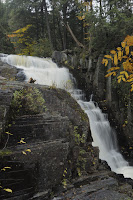A couple weeks ago a modest band of club members headed out on a  trek to Little Wilson Falls. Heck of an idea from one of our members. The weather was very much like today, though warmer. This was an exercise in: good information; reasoned decision making; determined effort; over preparation and plausible adventure.
trek to Little Wilson Falls. Heck of an idea from one of our members. The weather was very much like today, though warmer. This was an exercise in: good information; reasoned decision making; determined effort; over preparation and plausible adventure.First, good information. Truthfully, much improvement could be had on the information front. Somehow I reasoned the hike to the falls would be more of a lengthy stroll. This was failed reasoning. Little Wilson Falls is on the Appalachian Trail. In fact, it's part of the 100 mile wilderness. So, why I envisioned a stroll in the woods will remain an unanswered question. As a consequence some of our trekkers didn't have especially good footwear.
The weather was rainy in the morning. Some of the members knew what they were doing and brought along water resistant outerwear including pants. Wicked good idea! Wished I thunk uve it!!!
Now, reasoned decision making. My guide mentioned the hike to the falls was a bit over a mile. Ha! "Short walk that should be" I said to myself! So, I packed most of my camera gear into a pack and struck out with 35 pounds (plus or minus) of stuff. I thought about discarding an especially heavy lens, but my guide said "take it, you may need it!"

How gullible I be, and how he enjoyed exploiting my gullibility.
So, the heavy lens stayed in the pack. Everyone else had very
reasonable loads. I guess that showed where I stood in the
Good Judgement Section of the club.
Off we went down a modestly marked trail. Drizzly weather at first, but what's a little wet when great images await! Though much slipping and sliding was to be had, no broken bones or spirits were to be had [a little over the top on prose...]
Little Wilson Falls has tripod holes. There are few views to be had of this impressive cascade. The best views are to be had from a vantage not easily accessed. At least not by me. The sight is excellent. There are shots from above the falls, but you need to get in line for a shot at the falls from below! I expect an intrepid shooter could get across to the other side of the gorge for a full view, or do the 'salmon struggle' right up the stream (not recommended by me).
We had the company of hikers passing through. A couple of fellows who looked older than myself basically blew by me without sign of any exertion......don't I hate that!
The walk out proved to be the highlight. Apparently there are parallel trails. One is higher up from the Appalachian Trail, which is the one we took on the way in. The Appalachian Trail stayed near the flowage. The stretch from Little Wilson Falls down to the parking lot has many rips and small falls. The foliage wasn't at peak, but it was colorful.
We would have made a sight from above with members jagging off the trail looking for shooting opportunities then clamoring back up.
Despite the wet footing I took but one substantial "bottom bouncer". Much of the punishment was absorbed by my heavy backpack. Only seemed fair to me....
It was a very worth while effort. We now know of an excellent shooting location, and have a better sense of how to prepare. The upshot for me is you can never get enough experience. It would be better still if can remember what not to do the next time around.
By the way, our guide brought up a winter snowshoe adventure. How about a trek into Daicy Pond this February????
As an aside, I brought along my F5 (speaking of weight) and my lone roll of Kodachrome 25. The last lab processing Kodachromes will cease that effort in 2010. I saw no reason to wait exposing 36+ frames of this film. It came back earlier this week, and I think photographers (and Kodak) gave up on this film too early.
To quote Monty Python: "And now for something completely different."Some of you are having trouble getting to our 2009-2010 website. Webmaster Joel has the following advice:
"What happens is, the computer thinks it is being helpful by saving copies of web pages the first time you visit them, then just reloads the same thing from your hard drive the next time you visit that page. It does make those pages load faster, but it doesn't show you updates when changes are made. You need to go back to the calendar web page, then click the REFRESH or RELOAD icon in your Internet browser. In Microsoft Internet Explorer, it's called "Refresh." In Firefox, it's called Reload. You can also get to it by clicking on the View menu item in either browser."
So, no excuse for not keeping up with the club calendar! Thank you Joel for this information.
Our next competition topic is "Still Life". The competition date is November 19.